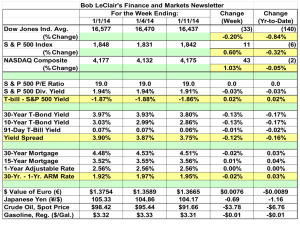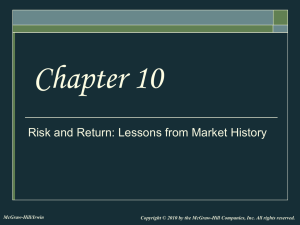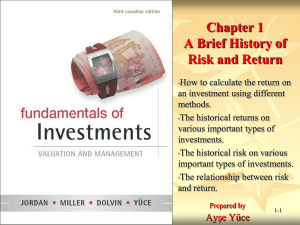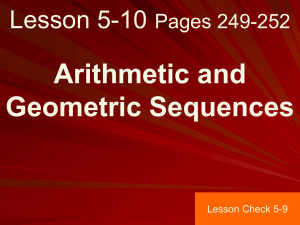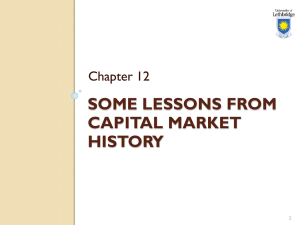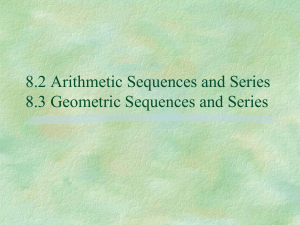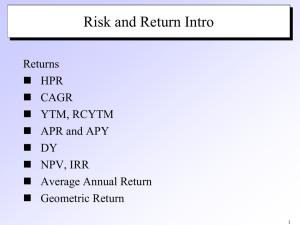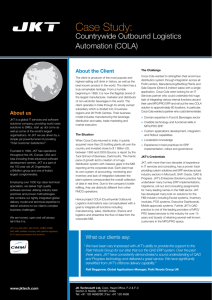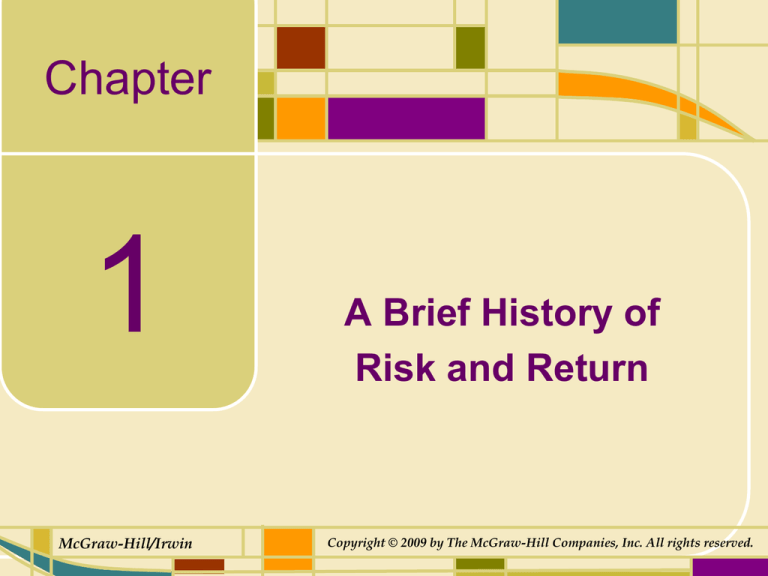
Chapter
1
McGraw-Hill/Irwin
A Brief History of
Risk and Return
Copyright © 2009 by The McGraw-Hill Companies, Inc. All rights reserved.
Learning Objectives
To become a wise investor (maybe even one with too
much money), you need to know:
• How to calculate the return on an investment using different
methods.
• The historical returns on various important types of investments.
• The historical risks of various important types of investments.
• The relationship between risk and return.
1-2
A Brief History of Risk and Return
• Our goal in this chapter is to see what financial market history can
tell us about risk and return.
• There are two key observations:
– First, there is a substantial reward, on average, for bearing risk.
– Second, greater risks accompany greater returns.
1-5
Return on Investment
• “The level of profit from an
investment - the reward for
investing.”
• Postponement of consumption
6
Components of Return
• Current income:
– dividends (stocks)
– interest (bonds)
– rent (real estate)
• Capital Gain (Loss):
– change in market value
7
“Total Return”
• “The sum of the current income
and the capital gain (or loss)
earned on an investment over a
specified period of time.”
8
Total Return Income CapitalGain (Loss)
Total Return Income CapitalGain (Loss)
TR I (EV - BV)
Total Return Income CapitalGain (Loss)
TR I (EV - BV)
I (EV - BV)
TR(%)
BV
Total Return (%)
•
•
•
•
•
•
TR(%) = (I + (EV – BV)) ÷ BV
I ÷ BV = ???
I ÷ BV = Dividend Yield
(EV – BV) ÷ BV = ???
(EV – BV) ÷ BV = Capital Gain Yield
Total Return = Dividend Yield +
Capital Gain yield
Example: Calculating Total Dollar
and Total Percent Returns
•
•
•
Suppose you invested $1,400 in a stock with a share price of $35.
After one year, the stock price per share is $49.
Also, for each share, you received a $1.40 dividend.
•
What was your total dollar return?
–
–
–
–
•
$1,400 / $35 = 40 shares
Capital gain: 40 shares times $14 = $560
Dividends: 40 shares times $1.40 = $56
Total Dollar Return is $560 + $56 = $616
What was your total percent return?
–
–
–
Dividend yield = $1.40 / $35 = 4%
Capital gain yield = ($49 – $35) / $35 = 40%
Total percentage return = 4% + 40% = 44%
Note that $616
divided by
$1400 is 44%.
1-16
Annualizing Returns, I.
• You buy 200 shares of Lowe’s Companies, Inc. at $48 per share.
Three months later, you sell these shares for $51 per share. You
received no dividends. What is your return? What is your annualized
return?
• Return: (Pt+1 – Pt) / Pt = ($51 - $48) / $48
= .0625 = 6.25%
This return is
known as the
holding period
percentage return.
• Effective Annual Return (EAR): The return on an investment
expressed on an “annualized” basis.
Key Question: What is the number of holding periods in a year?
1-17
Annualizing Returns, II
1 + EAR = (1 + holding period percentage return)m
m = the number of holding periods in a year.
•
In this example, m = 4 (there are 4 3-month holding
periods in a year). Therefore:
1 + EAR = (1 + .0625)4 = 1.2744.
So, EAR = .2744 or 27.44%.
1-18
$1 Invested in Different Portfolios:
1926-2006
Investment
Ending Value ($)
Small-Company Stocks
15,922.43
Large-Company Stocks
3,077.33
L-T Govt. Bonds
71.69
U. S. Treasury Bills
19.29
Inflation
11.26
19
A $1 Investment in Different Types
of Portfolios, 1926—2006.
1-20
The Historical Record:
Total Returns on Large-Company Stocks.
1-22
The Historical Record:
Total Returns on Small-Company Stocks.
1-23
The Historical Record:
Total Returns on U.S. Bonds.
1-24
The Historical Record:
Total Returns on T-bills.
1-25
The Historical Record:
Inflation.
1-26
Holding Period Return (HPR)
• “The total return earned from holding
an investment for a specified holding
period (usually 1 year or less).”
I (Ve Vb )
HPR
Vb
27
S & P 500 Annual Returns
Year
Total Return (%)
1995
1996
1997
1998
1999
2000
2001
2002
2003
2004
+37.58
+22.96
+33.36
+28.58
+21.04
-9.10
-11.89
-22.10
+28.68
+10.88
S & P 500 Annual Returns
Year
Total Return (%)
2000
2001
2002
2003
2004
2005
2006
2007
2008
2009
-9.10
-11.89
-22.10
+28.69
+10.88
+4.91
+15.79
+5.49
-37.00
?????
S & P 500 Annual Returns
Year
Total Return (%)
2000
2001
2002
2003
2004
2005
2006
2007
2008
2009
-9.10
-11.89
-22.10
+28.69
+10.88
+4.91
+15.79
+5.49
-37.00
+26.46
Average Returns: The First Lesson
• Risk-free rate: The rate of return on a riskless, i.e., certain
investment.
• Risk premium: The extra return on a risky asset over the risk-free
rate; i.e., the reward for bearing risk.
• The First Lesson: There is a reward, on average, for bearing risk.
• By looking at Table 1.3, we can see the risk premium earned by
large-company stocks was 8.5%!
1-37
Table 1.3: Historical Returns &
Risk Premiums (1926-2006)
Investment
Avg. Return
Premium
Large Co. Stocks
12.3%
8.5%
Small Co. Stocks
17.4%
13.6%
L-T Corp. Bonds
6.2%
2.4%
L-T Govt. Bonds
5.8%
2.0%
U. S. T-bills
3.8%
0.0%
Why Does a Risk Premium Exist?
• Modern investment theory centers on this question.
• Therefore, we will examine this question many times in the chapters
ahead.
• However, we can examine part of this question by looking at the
dispersion, or spread, of historical returns.
• We use two statistical concepts to study this dispersion, or variability:
variance and standard deviation.
•
The Second Lesson: The greater the potential reward, the greater the
risk.
1-40
Return Variability: The Statistical Tools
• The formula for return variance is ("n" is the number of returns):
R R
N
VAR(R) σ 2
i1
2
i
N 1
• Sometimes, it is useful to use the standard deviation, which is
related to variance like this:
SD(R) σ VAR(R)
1-41
Return Variability Review and Concepts
• Variance is a common measure of return dispersion. Sometimes,
return dispersion is also called variability.
• Standard deviation is the square root of the variance.
– Sometimes the square root is called volatility.
– Standard Deviation is handy because it is in the same "units" as the average.
• Normal distribution: A symmetric, bell-shaped frequency
distribution that can be described with only an average and a
standard deviation.
• Does a normal distribution describe asset returns?
1-42
Frequency Distribution of Returns on
Common Stocks, 1926—2006
1-43
Historical Returns & Standard
Deviations, 1926-2006
Series
Avg. Return
Std. Dev.
Large Co. Stocks
12.3%
20.1%
Small Co. Stocks
17.4%
6.2%
5.8%
5.4%
3.8%
3.1%
32.7%
8.5%
9.2%
5.7%
3.1%
4.3%
L-T Corp. Bonds
L-T Govt. Bonds
Int.-Term Govts.
U. S. T-bills
Inflation (CPI)
45
Historical Returns, Standard Deviations, and
Frequency Distributions: 1926—2006
1-46
The Normal Distribution and
Large Company Stock Returns
1-47
Arithmetic Averages versus
Geometric Averages
• The arithmetic average return answers the question: “What was your
return in an average year over a particular period?”
• The geometric average return answers the question: “What was
your average compound return per year over a particular period?”
• When should you use the arithmetic average and when should you
use the geometric average?
• First, we need to learn how to calculate a geometric average.
1-49
Compound Annual Return
• Geometric mean return
GM n (1 r1 )(1 r2 )...(1 rn ) 1
50
Compound Annual Return on the
S&P 500, 1995-99
GM9599 5 (1.37)(1.23)(1.33)(1.28)(1.21) 1
51
Compound Annual Return on the
S&P 500, 1995-99
GM9599 5 (1.37)(1.23)(1.33)(1.28)(1.21) 1
GM9599 5 3.4711 1
52
Compound Annual Return on the
S&P 500, 1995-99
GM9599 5 (1.37)(1.23)(1.33)(1.28)(1.21) 1
GM9599 3.4711 1
5
GM9599 1.2826 1 28.26%
53
Arithmetic Averages versus
Geometric Averages
• The arithmetic average tells you what you earned in a typical year.
• The geometric average tells you what you actually earned per year
on average, compounded annually.
• When we talk about average returns, we generally are talking about
arithmetic average returns.
• For the purpose of forecasting future returns:
– The arithmetic average is probably "too high" for long forecasts.
– The geometric average is probably "too low" for short forecasts.
1-55
Geometric versus Arithmetic Averages
1-56
Risk and Return
• The risk-free rate represents compensation for just waiting.
• Therefore, this is often called the time value of money.
• First Lesson: If we are willing to bear risk, then we can expect to
earn a risk premium, at least on average.
• Second Lesson: Further, the more risk we are willing to bear, the
greater the expected risk premium.
1-57
Historical Risk and Return Trade-Off
1-58
Useful Internet Sites
•
cgi.money.cnn.com/tools/millionaire/millionaire.html (millionaire link)
•
finance.yahoo.com (reference for a terrific financial web site)
•
www.globalfindata.com (reference for historical financial market data—
not free)
•
www.robertniles.com/stats (reference for easy to read statistics review)
1-60
Assignment
• Calculate the compound annual
return (geometric mean) of the
Standard & Poor’s 500 Stock Index
for the period 2000-2009.
• S&P 500 Return2000-2009 = ???
Problems: Chapter 2
• 2.19
• 2.20
• 2.25

